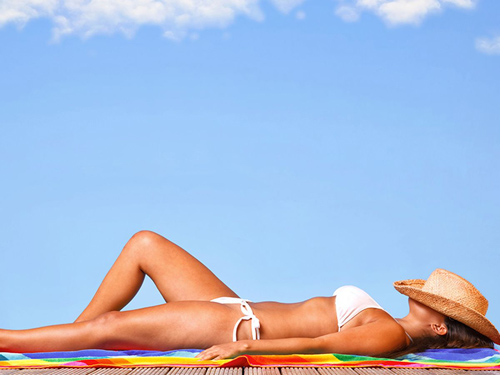
In summer, sunbathing is not only about getting a tan. We love the sun! we want to be outside, having fun, doing activities, playing on the beach, and whatever sun exposure we get will be considered sunbathing. More than resulting in a gorgeous sun-kissed glow, sun exposure actually boosts your mood, results in better sleep and helps in vitamin D production (necessary for healthy bones). So what’s the downside though? Too much of a good thing is ultimately bad, and too much sun will get you rashes, sunburns and even the risk of skin cancer.
So how should we approach sunbathing? We asked Dr. Costi for a few tips and compiled his answers in a list of do’s and don’ts that will help us avoid premature ageing.

1. Apply the right sunscreen
Go for SPF30 over SPF50 but don’t just rely on SPF; on the bottle you need to look for the term ‘broad spectrum’ or the UVA logo plus the word ‘high’.
If you have fair skin, high SPF filters 97% of UVB rays, while SPF50 filters 98%. Remember that even when you feel safe for applying the high protection factor, you must reapply it every two hours. If you have very dark skin then SPF15 is sufficient.
2. Eat sun-friendly foods
Certain foods are known to increase lycopene, which is the skin’s own SPF. This antioxidant found in tomatoes, and other red and orange fruit and vegetables can boost your sun protection by a whopping 33%. One of the best sources is tomato paste.
Green tea also contains polyphenols, which is a great example of antioxidants. We also recommend fish, rich in omega 3, the super anti-inflammatory.
And of course, yummy dark chocolate is packed with flavonoids that can help protect against sunburn, while caffeine is thought to help cut your skin cancer risk.
Espresso before we hit the beach?

3. Understand your tanning time
It’s useless to lounge by the pool all day, thinking you will get more tanned. The fact is that your skin reaches a tanning cut-off point when it physically can’t produce any more melanin, the tanning pigment.
Every skin type has a tanning cut-off, typically between 2 to 3 hours. After that you’re just subjecting your skin to the risk of UV damage, photoageing and premature wrinkles.
4. Seek some shade
Whatever you’re doing in the sun, taking breaks will reduce the UV intensity and your sunburn risks. This means your tan will be healthier and it will last longer.
Because how do we tan?
When you’re tanning, the UVA radiation penetrates deep into the skin, causing DNA damage. The body reacts by releasing melanin, the brown pigment desired by sun worshipers. This is the skin’s imperfect defense mechanism against further injury.
Now sunburn and redness are the result of the shorter but equally harmful UVB rays. However, prolonged exposure to either radiation can trigger DNA mutation that leads to skin cancer and damage.

5. Try tanning supplements
Apparently, tan-accelerating creams don’t work. But taking a beta-carotene supplement can actually help your skin get darker. It doesn’t mean you need less sunscreen, but it boosts skin’s natural defence against UV by improving its ability to tan.
Ask Dr. Costi for his favorite tablets which prepare the skin for the sun and protect cells from UV induced oxidative stress.
6. Fake your glow
A fake tan will not protect you from the sun, but it can help you be more confident those first few days of exposure on the beach. Treat yourself to a spray tan before the big bikini reveal or find the perfect one to use at home with our guide to fake tanning (http://drcosti.com/self-tanning-pro-tips-for-beginners/).
7. Avoid sunbeds
At all cost, you must not bake inside a sunbeds because they will not give you a healthy glow. No. they will give you skin cancer. Got it?
Tanning beds pump out huge amounts of UVA and virtually no UVB (which stimulates vitamin D), and can increase your risk of skin cancer by 75%.

And now repeat our summer mantra:
I am healthy, I am beautiful and I promise not to burn my skin.
Got it?